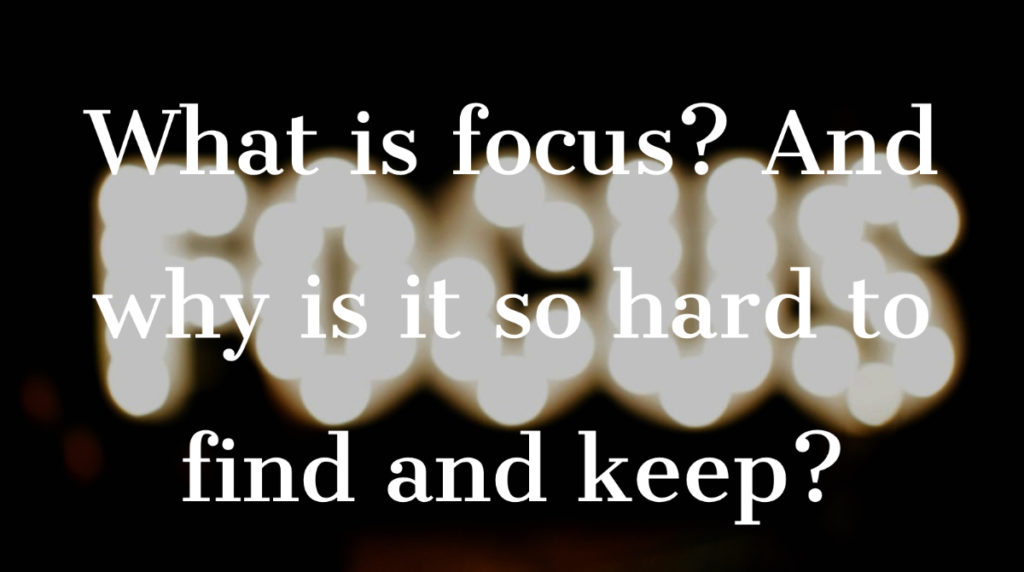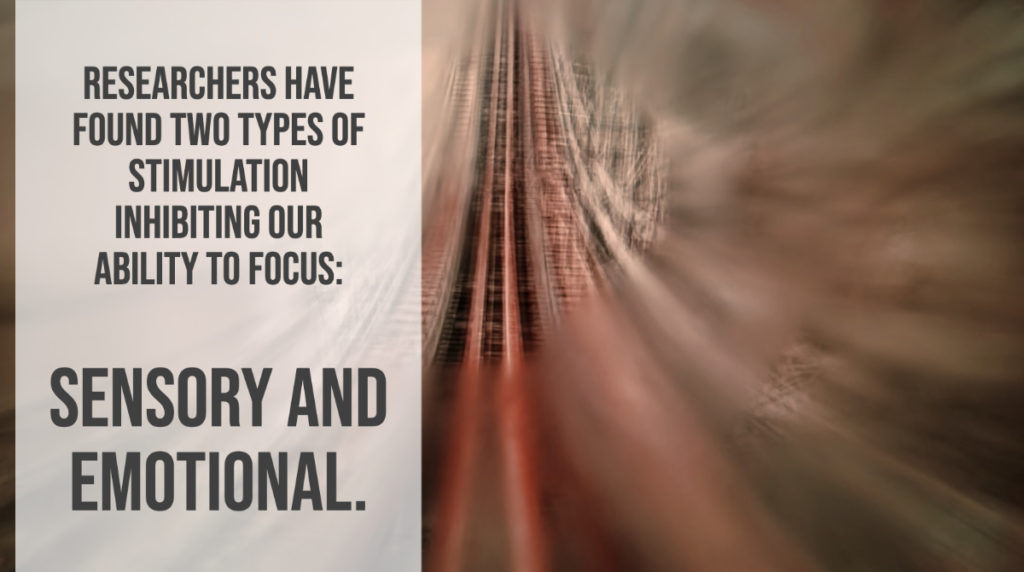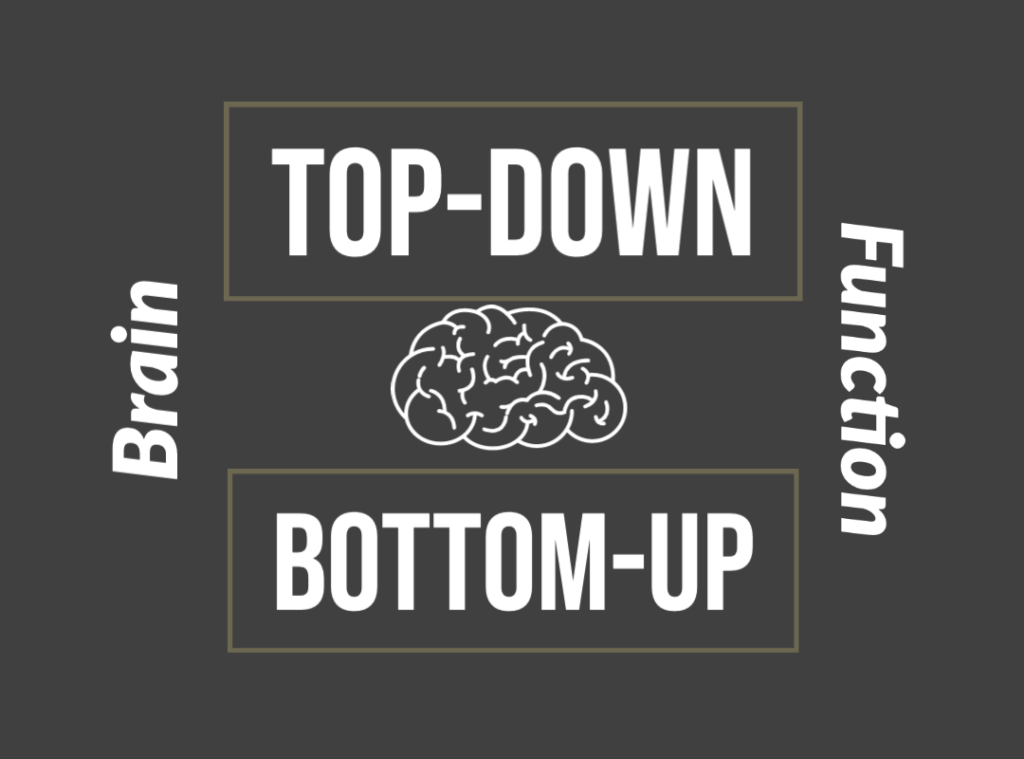“Not now. I need to focus.”
“Ugh. I just can’t seem to focus right now.”
How many times have you uttered these statements? If you’re like most of us, probably more times than you care to admit. And yet, we make those statements almost offhandedly, as if there’s nothing we can do about it other than hoping people leave us alone (which never happens and never works anyway!).
But what is focus? And why is it so dang hard to find and keep?

Why Focus is So Important
At its essence, focus is investing our entire being in one task, experience, or sensation. It’s the act of saying “yes” to one item, feeling, emotion, or conversation — and, just as importantly, saying “no” in the present to all other external or internal stimuli.
Focus is the essential and often secret ingredient that helps us remain on the path of consistent attention and high-level thinking.
The problem is that we sometimes don’t use focus for our ultimate good. We often use it in isolation to arrive at a particular place or goal. The issue with this practice is that once we achieve that triumph or check that box, we let our guard down and become lax. Thinking about focus this way leads to negligence, reduced potential, and ultimately disappointment.
Without focus, we find ourselves moving from task to task to task, limiting what we experience and achieve. We find ourselves unable to fulfill our purpose or live the life we have imagined for ourselves.
What happens is that we ultimately become a task tourist — doing things and checking off boxes, but failing to really experience our time and place.
Allowing ourselves to become emotional tourists feeds an addiction to instant gratification and leads us to a lack of investment in ourselves — even if it is subconsciously.
Not consciously investing in ourselves leads to mindless choices and giving in to emotionally-driven impulses. This gap, unfortunately, leads to activations (choices and actions) that keep us from moving towards our purpose. To change this, we need to acknowledge that there are two types of investment: micro and macro investments.
We can invest ourselves in a given moment, sentence, sensation, or situation we are navigating with our spouse — those are our micro-investments and are wildly different than the macro version.
We make macro investments when we invest our focus in our finances, our career, in the future of our family, our physical wellness, and in how we want the world to remember us.
Both types of investment are critical — but at different times and in different situations.
SO IT’S A BALANCE. And it’s hard.
It’s a constant decision between sacrificing our purpose for momentary investment and sacrificing momentary micro investment for our macro purpose.
This is why focus is so important. It cultivates a sustainable culture and a mental environment of prioritization. And, most importantly, it helps us find and sustain balance.
But, as you might have guessed, none of this is as simple as it sounds. That’s why we need to understand why focus is so hard.
The Two Things That Make Focus So hard
I’ll cut straight to the chase. Focus is hard because of one word: stimulation.
But it’s also not quite that simple.
We do not live in a silent, distraction-free zone. And that’s part of what we love about our existence: it’s dynamic, loud, and colorful.
But with that dynamism, we also introduce the brilliance of technology. And it IS brilliant. However, we are barraged from the moment we wake up. We grab our phone, check our messages, read emails, and scan notifications.
On top of the addiction to the immediate dopamine hits we get from checking our devices, we have the societal norms tempting and begging us to spend time and energy fitting in.
And there’s more. The overload of processed foods, coffee, and alcohol we consume stimulates us and revs up our nervous system, forcing it into overdrive.
By activating our sympathetic nervous system, increasing adrenaline and cortisol and thereby increasing inflammation at a gut and brain level, this barrage of stimulation sets us up for focus fatigue before we even get started.
So, yes, we struggle with focus because we’re overstimulated. But understanding exactly what those stimuli are and how they impact us is the key to overcoming it.

Researchers have found two types of stimulation inhibiting our ability to focus: sensory and emotional.
These two dynamic forms of stimulation appear everywhere in our lives. They can inspire us and be great for our productivity if we use them for good — or be incredibly detrimental to our progress and our relationship with our minds if we don’t.
Sensory stimulation is, well, just what it sounds like: the stuff you sense. You know, things like that backache, hang nail, annoying dog barking outside, weird taste in your mouth, or the array of “stuff” on your desk.
Emotional stimuli are often more challenging to navigate and reduce. You may see or experience thousands of things that could activate an impulse within you to engage emotionally throughout your day. A photo, a scent, a sensation, or even a single word may bring you back to a given moment in time, viscerally tempting you to experience that moment.
But to understand why focus is so hard, we need to know how all this stimulation affects us.
The Physiology of Focus
So, what’s happening inside of our brains when all of this is going on?
As you can imagine, there are many parts at play, but at the risk of over-simplifying, let’s start here: there are two main ways our brain operates that we can understand as top-down and bottom-up circuitry.
The bottom-up function is intuitive, impulsive, involuntary, and automatic. It’s fast and executes our habits.
Top-down circuitry is run by the executive decision-maker part of our brain, and is much slower, more deliberate, and voluntary. And it helps keep us in check when we veer towards emotionally-driven impulses or habits. Top-down function is tremendously helpful with cultivating empathy, self-awareness, intentional planning, and executive decision-making.

You might be thinking, “Jeez, who wants to function bottom up? It’s the most ancient protocol of brain function, and who wants to be THAT primitive. I don’t do that, do I?”
Well, it’s not that simple.
Just like we need to balance our micro and macro investments, our top-down and bottom-up circuitry is balanced to help the brain do what it does best: be economical.
Our brain, and specifically our prefrontal cortex, wants to conserve as much energy as possible to make the bigger, more critical decisions and activations. So anything that it can hand off to bottom-up circuitry and convert into automatic function, it will.
And like any mechanism, when we use our prefrontal cortex (PFC: the top-down function) long enough, it gets T I R E D and needs a recharge, especially if we’re using it frivolously.
When that happens, our basal ganglia (the bottom-up side) takes over and makes us more susceptible to the emotionally-driven impulses and the barrage of stimulation bombarding us that our PFC usually handles.
The results is our ability to focus wanes. It all makes perfect sense once you understand what’s happening inside your brain.
Some Good News
The upside of all this information is that once we begin to understand what’s happening, it also becomes clear what we need to do to change it. With a bit of effort, time, and patience, it IS possible to rewire our brain for focus by using these same brain attributes to our advantage. And that means that we can achieve our purpose and live the life we want.
This understanding also helps us have patience with ourselves when stimulation gets the better of us, and gives us hope that through purposeful routine, we can cultivate sustainable change!
